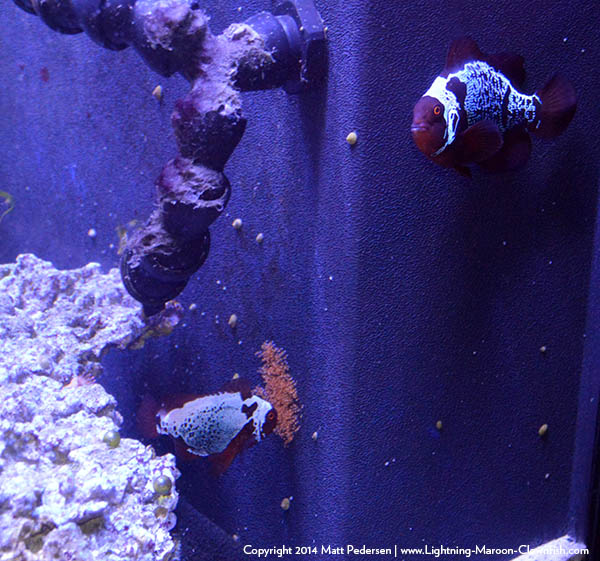We all were holding out hope that, just as the first matings of two Picasso Percula Clownfish yielded a 2nd new designer form of clownfish, so too people anticipated that the mating of two Lightning Maroon Clownfish would hopefully create something “new” as well. The saga of the Lightning Maroon Clownfish entered this a new stage with the first F1 pairing of Lightning Maroon Clownfish spawning at my home on October 2nd, 2014.
It’s taken 5 spawns to get viable juveniles out of the first spawning pair of F1 Lightning X Lightning Maroon Clownfish, these being offspring from the first batch that were reared. Settlement on the 5th spawn was observed around November 28th, 2014. Now, 12-9-2014, I finally got to review the babies (which were being reared by my good friend and fellow marine breeder Mike Doty, who tends the fishroom when I’m away).
The short answer is this – so far we see nothing new. Earlier in the process Mike had reported that he felt there were two phenotypes and a roughly 50/50 ratio…not unlike the first generation Lightning Maroons from the wild pairing. When I took a slightly more detailed headcount today, I counted roughly 3 white stripe offspring, and 6 lightning offspring. Again, I saw nothing out of the ordinary that would suggest anything new.

For the moment, it’s fair to say that Lightning genetics appear to be headed in the direction of Snowflake genetics in Amphiprion ocellaris. Snowflake, as best as we can gather at this point in time, appears to be a straight dominant gene. Additionally, it appears that homozygous (double-dose) Snowflake Ocellaris don’t exist, as no one has been able to demonstrate a Snowflake X Snowflake pairing that can produce 100% Snowflake offspring, and the offspring spreads of Snowflakes routinely fail to fit the typical understanding that would support the existence of live, homozygous (S/S) fish.
The likely explanation being that this genetic state, inheriting a Snowflake gene from both your mother and father, may be fatal to those larvae and they fail to show up in rearing headcounts. As we get more data on Snowflake X Snowflake pairings, it seems to suggest that a 33% wild type / 66% snowflake spread is where the matings of two snowflakes result. And unsurprisingly, this is the same split as the very first batch of offspring of Lightning X Lightning.
It is a bit premature to claim that we have definitive answers. The sample size is VERY small right now. The babies are still incredibly young and it’s impossible to see what they will develop like. There still could be something new; a double-dose Lightning Maroon Clownfish could exist, and it could look the same as a single-dose, or unlike anything we’ve ever seen. The name “Thunder” has already been tossed about by Mike Doty should a new phenotype emerge (long time Reef Builders readers may recall Mike Hoang’s Goldflakes, which he initially called Thunders…Hoang has already conceded that the name Thunder here would be very appropriate).
Additional data from future spawns, particularly larger clutches, will be helpful. Rumors are that a second pair of Lighting X Lightning has spawned, and the observations from additional pairs that have been set up will add to our understanding of this interesting wild-originated mutation.



